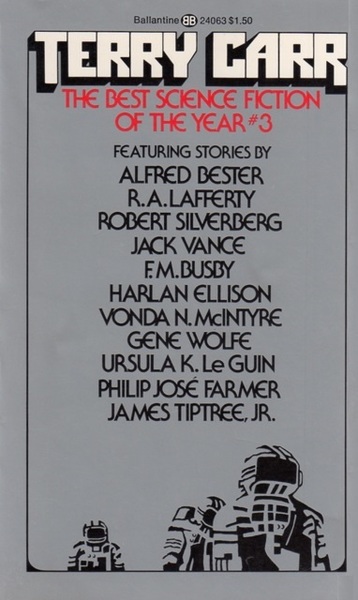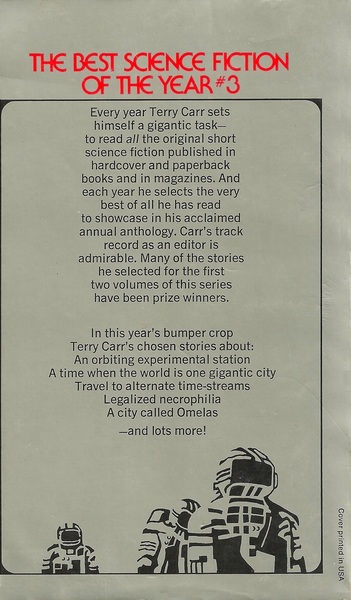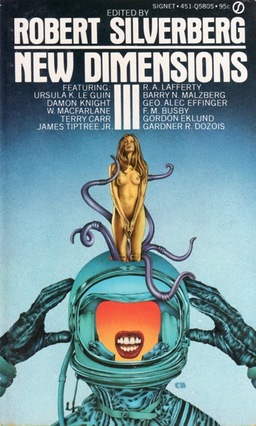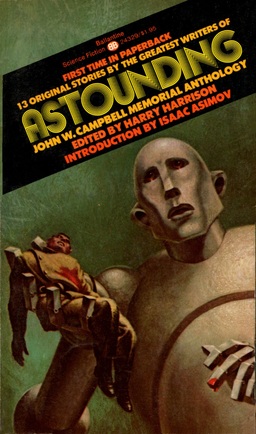Vintage Treasures: The Best Science Fiction of the Year #3, edited by Terry Carr
 |
 |
How did Terry Carr’s Best Science Fiction of the Year paperback anthology series last an incredible sixteen years, from 1972 until his death in 1987?
It’s not that hard to figure out. When early volumes were as amazing as #3, released in July 1974, it didn’t take long for these books to establish a stellar reputation — and a staunchly loyal readership.
How incredible was The Best Science Fiction of the Year #3?
It contains some of the finest science fiction stories of all time, packed into one slender volume. Like “The Women Men Don’t See” by James Tiptree, Jr… perhaps her most famous story, and that’s saying something. And Vonda N. McIntyre’s Nebula Award-winning “Of Mist, and Grass, and Sand,” which became the basis of her 1978 novel Dreamsnake (which swept the Hugo, Nebula, and Locus Awards the following year.) And Harlan Ellison’s classic “The Deathbird,” the Hugo and Locus Award-winning title story of his celebrated 1975 collection Deathbird Stories. Plus Gene Wolfe’s famous “The Death of Dr. Island,” winner of the Locus and Nebula awards for Best Novella.
And an unassuming little story by a young writer named Ursula K. Le Guin, “The Ones Who Walk Away from Omelas,” which won the Hugo Award for Best Short Story, and is considered by many (me included) to be one of the finest short stories ever written. And lots more — including a Jack Vance novella, plus stories by Philip José Farmer, Alfred Bester, R. A. Lafferty, Robert Silverberg, and F. M. Busby. All for $1.50!
[Click the images for bigger versions.]
 Now, I don’t mean to go off on a rant about how fabulous old SF anthologies used to be. I want to state for the record that I find the work being done by Jonathan Strahan, Rich Horton, Gardner Dozois and others in the current crop of Year’s Best anthologies to be top notch.
Now, I don’t mean to go off on a rant about how fabulous old SF anthologies used to be. I want to state for the record that I find the work being done by Jonathan Strahan, Rich Horton, Gardner Dozois and others in the current crop of Year’s Best anthologies to be top notch.
In fact, I spent some time back in June reading a bunch of old SF digests from the early 70s — while doing research for a piece on the next volume in this series, Carr’s The Best Science Fiction of the Year #4, oddly enough — and in general I was underwhelmed. There were bright spots here and there, sure, but overall the sexism was appalling, the writing not much better, and the writers seemed concerned with all the wrong things. Give me a modern issue of Lightspeed, Clarkesworld, or Asimov’s SF any day.
It did make me curious about a few things, though. For one, how did Terry Carr manage to wring such gems out of those same digests, year after year? Yeah, even 40 years later Carr still has a reputation for editorial wizardry, but even he couldn’t conjure up a whole book of SF masterpieces out of nothing.
A quick glance over the table of contents (below) reveals that Carr wasn’t really drawing from the digests at all, however. Of the 11 tales in The Best Science Fiction of the Year #3, only three came from magazines: Ellison’s “The Deathbird” from F&SF, McIntyre’s “Of Mist, and Grass, and Sand,” which appeared in Analog, and Tiptree’s “The Women Men Don’t See,” also from F&SF. The rest came from original anthologies like Universe, New Dimensions, and Nova, which were clearly the premiere short fiction markets of the day.
Not that much different from today, I suppose. The original anthology series is just about dead, but one that soldiers on, Jonathan Strahan’s terrific Infinity series from Solaris Books, has proven to be a rich resource for Year’s Best volumes. In fact the most recent installment, Meeting Infinity, was clearly the most successful anthology of 2015, just based on the amazing number of stories it had reprinted.
But the thing I’m really curious about is this: is Terry Carr’s anthology impressive because it gathers together so many stories we still celebrate today? Or are the stories still celebrated today because they appeared in Terry Carr’s anthology?
It’s not really that far-fetched a suggestion. In the days before the internet, you didn’t have every award nominee instantly at your fingertips. When nomination season rolled around, last year’s magazines were long gone. Where did you look for suggestions and ideas? Why, the Year’s Best anthologies, of course. And there was simply no more widely read and influential editor than Terry Carr.
I don’t think it’s coincidence that so very many Hugo, Nebula, and Locus awards went to Terry Carr’s choices. Rather, I see it as evidence of the strength of his influence on the SF short fiction field, both as editor of The Best Science Fiction of the Year and Universe — and other fine anthologies.
 So when I picked up this anthology yesterday, shaking my head in amazement at just how prescient Terry Carr was in picking out the stories that I still find incredible 42 years later, I think maybe I had it all wrong. Maybe I find these stories incredible because Terry picked them out 42 years ago… and if he hadn’t, I might not know about them at all.
So when I picked up this anthology yesterday, shaking my head in amazement at just how prescient Terry Carr was in picking out the stories that I still find incredible 42 years later, I think maybe I had it all wrong. Maybe I find these stories incredible because Terry picked them out 42 years ago… and if he hadn’t, I might not know about them at all.
And that’s even more impressive.
Here’s the complete TOC for The Best Science Fiction of the Year #3.
Introduction by Terry Carr
“Something Up There Likes Me” by Alfred Bester (Astounding: John W. Campbell Memorial Anthology, November 1973)
“The World as Will and Wallpaper” by R. A. Lafferty (Future City, July 1973)
“Breckenridge and the Continuum” by Robert Silverberg (Showcase, June 1973)
“Rumfuddle” by Jack Vance (Three Trips in Time and Space: Original Novellas of Science Fiction, 1973)
“Tell Me All About Yourself” by F. M. Busby (New Dimensions 3, October 1973)
“The Deathbird” by Harlan Ellison (The Magazine of Fantasy and Science Fiction, March 1973)
“Of Mist, and Grass, and Sand” by Vonda N. McIntyre (Analog Science Fiction/Science Fact, October 1973)
“The Death of Dr. Island” by Gene Wolfe (Universe 3, October 1973)
“The Ones Who Walk Away from Omelas” by Ursula K. Le Guin (New Dimensions 3, October 1973)
“Sketches Among the Ruins of My Mind” by Philip José Farmer (Nova 3, 1973)
“The Women Men Don’t See” by James Tiptree, Jr. (The Magazine of Fantasy and Science Fiction, December 1973)
Honorable Mentions
Our recent coverage of Terry Carr includes:
Decadent Alien Races and Electricity Creatures: Rich Horton on Warlord of Kor/The Star Wasps (1963)
World’s Best Science Fiction 1965 – 1970, edited by Donald A. Wollheim and Terry Carr (1965-1970)
The Best Science Fiction of the Year #3, edited by Terry Carr (1974)
The Best Science Fiction of the Year #4, edited by Terry Carr (1975)
The Best Science Fiction 1974, edited by Lester del Rey, Terry Carr, and Donald Wollheim
A Return to Terry Carr’s Best Science Fiction of the Year
Creatures From Beyond, edited by Terry Carr (1975)
Classic Science Fiction: The First Golden Age, edited by Terry Carr (1978)
The Best Science Fiction Novellas of the Year 1, edited by Terry Carr (1979)
Thomas M. Disch on the Best Science Fiction of 1979
Universe 13 edited by Terry Carr (1983)
The Best Science Fiction of the Year #3 was published by Ballantine Books in July 1974. It is 368 pages, priced at $1.50 in paperback. The cover is by Larry Sutton.
See all of our recent Vintage Treasures here.
Holy cow – you don’t see many lineups like that any more!
I know, right?
This from the Encyclopedia of Science Fiction (the entry is “Anthologies”):
“Tastes in these matters are subjective, but the critical consensus is clearly that Terry Carr’s selection was on the whole the most reliable through to the mid-1980s, and that his mantle has passed to Gardner Dozois, whose selection is now both the biggest and the best, each volume being introduced by an extensive essay on changes and developments in the sf world (including a sad litany of deaths) through the relevant year. Carr’s and Dozois’s “Year’s Best” collections are required reading for anybody seriously interested in sf in short forms.”
Because these anthologies shine so strongly in hindsight, I’ve started to accumulate a collection of them. Coincidentally, Terry Carr’s #3 is the last one I ordered from a second hand supplier.
Science Fiction (and fantasy to a lesser extent) has been very well served by the various “Year’s Best” editors. Over the years, there have been quite a lot of these series, but they’re all good. Some stand out a bit more, but there’s no annual series that can be written off, certainly not on the SF side (I’m very much less familiar with the various annual fantasy series). I think fans of old short work are very lucky in that respect.
That’s maybe an idea for a future post: outlining the history of Year’s Best Fantasy series … the ones that set out to exclude SF.
That book is the first Best of the Year collection I ever bought, in 1974 (not coincidentally the first year I was really buying books). I was obvious even to a 14 year old that Carr was where the cool action was, and the competing Wollheim Best of the Year was a fusty old thing.
Fantastic article, John! Terry Carr was THE Editor. Just about every one of my favorite writers I first encountered in his anthologies. He knew what made for a great story, and “from him” I learned what makes for a great story. We’ll never see his likes again.
> “Tastes in these matters are subjective, but the critical consensus is clearly that Terry Carr’s selection was on the whole the most reliable through to the mid-1980s,
> and that his mantle has passed to Gardner Dozois, whose selection is now both the biggest and the best, each volume being introduced by an extensive essay on changes
> and developments in the sf world (including a sad litany of deaths) through the relevant year. Carr’s and Dozois’s “Year’s Best” collections are required reading
> for anybody seriously interested in sf in short forms.”
Dolphin,
That’s a great quote! (And I happen to agree with it.) Thanks for sharing it.
> Science Fiction (and fantasy to a lesser extent) has been very well served by the various “Year’s Best” editors. Over the years, there have been quite a lot of these series,
> but they’re all good. Some stand out a bit more, but there’s no annual series that can be written off, certainly not on the SF side.
Hear hear! I think you’re absolutely right. Every single one of the BEST OF THE YEAR series championed a certain set of writers, and I think the genre as a whole owes a debt of gratitude to them for helping promote and launch a lot of careers.
> I think fans of old short work are very lucky in that respect.
For sure. Before the internet, these books were often the ONLY way many short story writers were kept in print for new readers to discover. Today, they’re a great way to discover neglected gems.
> That’s maybe an idea for a future post: outlining the history of Year’s Best Fantasy series … the ones that set out to exclude SF.
That’s a fabulous idea. All I have to do now is find someone to write it!
> That book is the first Best of the Year collection I ever bought, in 1974 (not coincidentally the first year I was really buying books).
Rich,
You were well ahead of me, then. The first one I bought was 1977’s The Best Science Fiction of the Year #6, with that bright red cover. It contained Damon Knight’s “I See You,” Asimov’s “Bicentennial Man,” and George R. R. Martin’s chilling “Meathouse Man” (40 years later and the memory of that story still chills me.)
> I was obvious even to a 14 year old that Carr was where the cool action was, and the competing Wollheim Best of the Year was a fusty old thing.
Again, you were ahead of me… I didn’t try Wolheim’s series for several years. And that first Carr collection in 77 was a bit much for my 12-year-old mind. (I blame “Meathouse Man”…. brrrrr.)
> Fantastic article, John! Terry Carr was THE Editor… We’ll never see his likes again.
You’re probably right, Joe. But folks like Jonathan Strahan and Rich Horton are doing great work bringing attention to the best writers working today…. give it 30 years, and perhaps folks will be saying we’ll never see another Horton or Dozois in our lifetime!
Somebody has to say it, though – what a lame cover.
Yeah, the cover is pretty flat, but you have to respect an anthology that represents itself primarily with a list of its contributors.
And that’s a list of contributors that would stop in their tracks most any SF fan browsing the shelves.
I agree that the cover is underwhelming. But I still prefer it to the flat primary color design Del Rey used when they re-issued the books a few years later.
Over the decades, I’ve kinda gotten fond of this cover. I think of it as the purest expression of that old SF trope: human explorers into the unknown. They even have different personalities. The guy in front is the leader, the risk-taker, the one fully engaged with the mission. The guy behind him is the cautious one, always looking down, apprehensive of the unknown. The guy in the back, shoulders slightly hunched, is the one you need to worry about. He’s suspicious of the whole mission. He’s the one who’s going to cut and run just when bravery is needed most, as the alien generator starts to power up, abandoning the other two to a terrible fate.
Aw. That’s beautiful. I thought I was the only guy who made up stories about cryptic covers.
When I acquired a copy of #1 I got the 1976 reprint. Unfortunately, this reprint doesn’t have Terry Carr’s list of Honorable Mentions, which I would’ve liked to see. Is there anyone who can send me a scan of those two (three at most) pages?
There are three stories in the book from the magazines…two, and two of the best, from F&SF….Edward Ferman rarely gets enough credit. Though Ellison’s “The Deathbird” is both one of the best stories he’s written and not remotely science fiction, as opposed to fantasy incorporating a fine bit of memoir.
The original anthologies, with their longer lead times (one or two volumes/issues per year, if that) didn’t have that much to be credited for in comparison…particularly when we consider the financial hurdles the magazines were facing that the book publishers were not, at least not to the same degree. But you, John, have some first-hand sense of this.
> Unfortunately, this reprint doesn’t have Terry Carr’s list of Honorable Mentions, which I would’ve
> liked to see. Is there anyone who can send me a scan of those two (three at most) pages?
dolphintornsea,
Here you go! Click for bigger versions.
> There are three stories in the book from the magazines…two, and two of the best, from F&SF….
Todd,
Right you are! Good catch — I’ve corrected it in the text.
> The original anthologies, with their longer lead times (one or two volumes/issues per year, if that) didn’t have that much
> to be credited for in comparison…particularly when we consider the financial hurdles the magazines were facing
Perhaps… but if that were true, why are there so few truly extraordinary anthologies? Ultimately, I think it comes down to editorial taste, and a publisher willing to back the project with a decent budget. I don’t want to take anything away from those anthology editors who accomplished miracles (frequently with modest budgets) by building markets that were so prestigious that writers were dying to get into them. I’m thinking ORBIT, UNIVERSE, NEW DIMENSIONS… these were prestige markets, and that prestige came from the star power of their editors.
> The original anthologies, with their longer lead times (one or two volumes/issues per year, if that) didn’t have that much
> to be credited for in comparison…particularly when we consider the financial hurdles the magazines were facing
Perhaps… but if that were true, why are there so few truly extraordinary anthologies?
–Well, that would be my point. The magazines could run some routine material (or even more likely, fiction that the editors wouldn’t take under ideal circumstances, but were willing to take a chance on because space needed to be filled), but so too did the anthologies, even the best of them (Knight’s ORBIT has often been damned for doing so, for example). The editors of the original anthology series we remember most fondly were often extremely talented writers who were also talented editors…and that includes Samuel Delany and Marilyn Hacker at QUARK and the various editors of the NEW WORLDS anthology series once it left magazine format. But while most of the editors of the magazines in the ’70s weren’t writers primarily…Ben Bova and Ted White being the notable exceptions, and even they at least as busy as editors…the magazines often managed to offer at least comparable quality to the anthologies, on balance. For good and at times for ill.
And in your prozine reading for the Carr BOTY 4, you mention reading only selected stories from ANALOG…not the best of the 1970s magazines, though the bestselling (the only one published by a major magazine publisher) till ASIMOV’S began outselling it by the end of the decade. Ah, well.